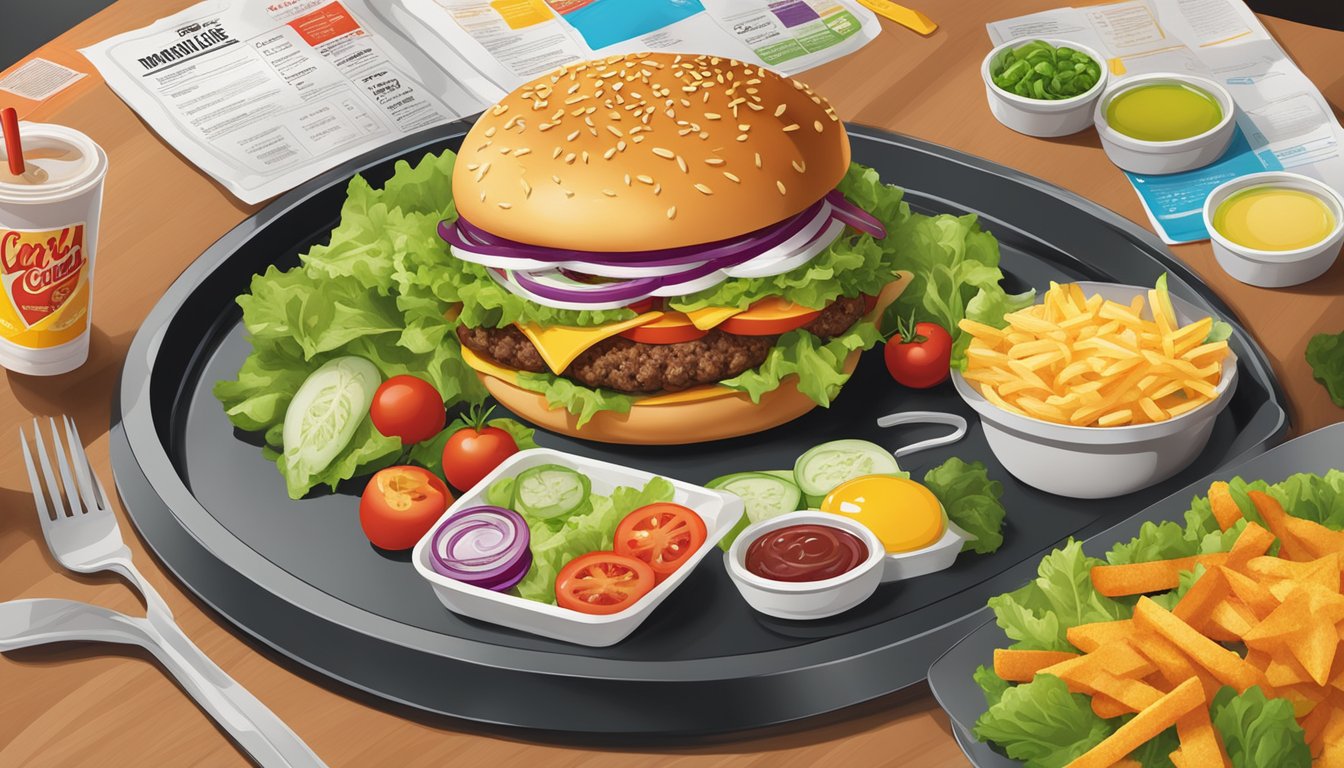Carl’s Jr. has long been known for its indulgent burgers and bold flavors. While taste remains a priority, the fast food chain also offers options for health-conscious diners. Understanding the nutritional content of menu items can help customers make informed choices that align with their dietary goals.
Carl’s Jr. provides a range of menu options, from high-calorie burgers exceeding 1,000 calories to lighter fare like grilled chicken salads. The Big Carl, for example, contains 930 calories and 58 grams of fat, while some salads offer under 300 calories. This variety allows customers to select meals that fit their nutritional preferences.
Nutrition information for Carl’s Jr. menu items is readily available, enabling diners to track calories, fat, protein, and other key nutrients. By examining this data, customers can balance their cravings for tasty fast food with their health objectives, making Carl’s Jr. a viable option for those seeking both flavor and nutritional awareness.
Understanding Nutrition at Carl’s Jr.

Carl’s Jr. offers a diverse menu with varying nutritional profiles. The chain provides detailed nutrition information to help customers make informed choices about their meals.
Breaking Down Nutrient Content
Carl’s Jr. menu items range widely in calorie content. Burgers typically contain 800-1000 calories, while some options exceed 1000 calories. The Big Carl, for example, has 930 calories.
Protein levels in burgers are generally high, with many options providing 40-50 grams. Carbohydrate content varies, often falling between 60-80 grams per burger.
Sodium is a significant factor in Carl’s Jr. meals. Many items contain over 1000mg of sodium, with some exceeding 1500mg. The Breakfast Burger, for instance, has 1600mg of sodium.
Balancing Taste and Health
Carl’s Jr. offers healthier alternatives alongside its indulgent options. Grilled chicken sandwiches and salads typically have fewer calories and less fat than beef burgers.
Some menu items provide a balance of nutrients. The chain’s breakfast options, like burritos and tacos, offer protein and carbs in smaller portions, ranging from 210-260 calories for tacos.
For those watching their intake, Carl’s Jr. provides customization options. Removing cheese or sauce can significantly reduce calorie and fat content. Opting for a lettuce wrap instead of a bun cuts carbs substantially.
Menu Overview

Carl’s Jr. offers a diverse menu featuring hearty burgers, crispy sides, and lighter fare. The restaurant balances indulgent options with healthier choices to cater to various dietary preferences and nutritional needs.
Burgers & Sandwiches
Carl’s Jr. is renowned for its charbroiled burgers. The menu features classic options like the Famous Star and Big Carl, alongside specialty burgers such as the Western Bacon Cheeseburger and Guacamole Bacon Angus Burger.
Calorie counts vary widely, with the Famous Star containing 670 calories and the Big Carl packing 930 calories. Protein content ranges from 30 to 47 grams per burger.
For those seeking lighter options, Carl’s Jr. offers chicken sandwiches and wraps. The Charbroiled Chicken Club Sandwich provides a leaner alternative with 640 calories and 37 grams of protein.
Sides & Snacks
Carl’s Jr.’s side menu is dominated by french fries, available in natural cut and crisscut varieties. A small order of Natural Cut French Fries contains 300 calories and 14 grams of fat.
Other popular sides include onion rings and fried zucchini. For a protein boost, customers can add a side of chicken stars or chicken tenders to their meal.
The dessert menu features hand-scooped ice cream shakes in flavors like chocolate, vanilla, and strawberry. These indulgent treats range from 600 to 800 calories per serving.
Salads & Healthier Options
Carl’s Jr. caters to health-conscious diners with a selection of salads and lower-calorie options. The Charbroiled Chicken Salad is a popular choice, containing 280 calories and 32 grams of protein.
For burger enthusiasts looking to cut carbs, Carl’s Jr. offers lettuce-wrapped versions of their popular burgers. The Low Carb Thickburger, for instance, provides 420 calories and 36 grams of protein.
The menu also includes a side salad option and apple slices for those seeking lighter alternatives to traditional sides. These choices allow customers to build more balanced meals while still enjoying Carl’s Jr.’s signature flavors.
Burger Highlights
Carl’s Jr. offers a diverse range of burgers to satisfy different tastes and appetites. From classic favorites to innovative creations, the menu features options that balance indulgence with nutritional considerations.
Classic Selections
The Famous Star with Cheese stands as a Carl’s Jr. icon. This burger contains 670 calories, 41g of protein, and 38g of fat. The Double Cheeseburger packs more punch with 920 calories, 52g of protein, and 58g of fat.
For those craving smoky flavors, the Western Bacon Cheeseburger delivers. It has 770 calories, 37g of protein, and 41g of fat. The addition of onion rings and BBQ sauce gives it a unique twist.
The Big Carl, a heftier option, boasts 920 calories, 51g of protein, and 59g of fat. It features two charbroiled beef patties and Carl’s Jr.’s signature sauce.
Innovative Twists
The California Classic Double Cheeseburger offers a fresh take on the traditional burger. It includes 920 calories, 51g of protein, and 62g of fat. The addition of guacamole and bacon gives it a California-inspired flair.
Carl’s Jr. also caters to those seeking plant-based alternatives. Their Beyond Famous Star, made with a plant-based patty, contains 710 calories, 30g of protein, and 40g of fat.
For breakfast enthusiasts, the Monster Biscuit provides a hearty start to the day. With 820 calories, 36g of protein, and 55g of fat, it combines eggs, bacon, sausage, and cheese on a biscuit.
Monster Creations
The 1/2 lb. Guacamole Bacon Thickburger lives up to its “monster” name. It packs 1,210 calories, 63g of protein, and 87g of fat. The combination of guacamole, bacon, and a hefty patty creates a flavor-packed experience.
For cheese lovers, the 1/3 lb. Original Six Dollar Thickburger offers 1,050 calories, 55g of protein, and 69g of fat. It features two slices of American cheese and Carl’s Jr.’s signature sauce.
The Bacon Western Cheeseburger takes indulgence to new heights with 1,040 calories, 57g of protein, and 66g of fat. It combines the classic Western Bacon Cheeseburger with extra bacon for added flavor.
Breakfast Choices

Carl’s Jr. offers a diverse breakfast menu that balances indulgent flavors with nutritional considerations. From hearty sandwiches to savory burritos, the options cater to various tastes and appetites.
Traditional Breakfast Offerings
Carl’s Jr. serves up classic breakfast items with a twist. The Big Country Breakfast Burrito packs a flavorful punch, filled with eggs, sausage, hash browns, and cheese. For those seeking a simpler start, biscuits and gravy provide a comforting option.
The menu also features standalone biscuits for a lighter choice. These items offer a range of calorie counts, allowing customers to make informed decisions based on their dietary needs.
Breakfast Sandwich Varieties
Breakfast sandwiches form a core part of Carl’s Jr.’s morning menu. The Breakfast Burger stands out as a unique offering, combining a beef patty with egg, bacon, and cheese on a bun. It contains 810 calories and 41g of fat.
The Grilled Cheese Breakfast Sandwich comes in ham and sausage varieties. The ham version has 490 calories and 24g of fat, while the sausage option contains 640 calories and 41g of fat. These sandwiches provide protein-rich meals to fuel the day ahead.
Breakfast Burritos & More
Carl’s Jr. expands beyond traditional offerings with its burrito selection. The Loaded Breakfast Burrito delivers a satisfying meal with 42g of fat and a significant calorie count. It’s a popular choice, with 68% of customers rating it favorably.
For those watching their intake, Carl’s Jr. provides nutritional information for all items. This transparency allows guests to make choices aligned with their dietary goals. The breakfast menu balances indulgent options with more moderate selections to cater to a range of preferences.
Chicken and More

Carl’s Jr. offers a diverse selection of chicken options, from classic sandwiches to crispy tenders and unique specialty items. These menu choices provide alternatives to beef burgers while catering to different taste preferences and nutritional needs.
Chicken Sandwiches
The charbroiled BBQ chicken sandwich is a popular choice, featuring a grilled chicken breast with tangy barbecue sauce. For those seeking a spicier kick, the spicy chicken sandwich delivers heat without sacrificing flavor. The big chicken fillet sandwich satisfies larger appetites with its substantial portion size.
Carl’s Jr. also offers a hand-breaded bacon swiss chicken sandwich, combining crispy chicken with savory bacon and melted swiss cheese. This option provides a indulgent twist on the classic chicken sandwich formula.
Tenders & Nuggets
Carl’s Jr.’s hand-breaded chicken tenders are a crowd-pleaser, available in various serving sizes. These tenders are made from white meat chicken and offer a satisfying crunch. The 5-piece hand-breaded chicken tenders contain 440 calories, with 37% coming from protein and 43% from fat.
For a bite-sized option, Chicken Stars are a fun alternative. A 6-piece serving of Chicken Stars contains 260 calories, with 54% of those calories coming from fat. Customers can opt for a smaller 4-piece serving to reduce calorie intake by 90 calories.
Specialty Chicken Selections
Carl’s Jr. expands its chicken offerings with unique selections that cater to diverse tastes. These items often feature special seasonings, sauces, or preparation methods to set them apart from standard menu options.
Some locations may offer limited-time chicken specials or regional favorites. These specialty items allow customers to explore new flavor combinations while still enjoying the familiar quality of Carl’s Jr.’s chicken.
Nutritional information for these specialty items can vary, so health-conscious diners should check the restaurant’s current nutritional guide for specific details.
Sides Exploration

Carl’s Jr. offers a diverse selection of side dishes to complement their main menu items. These sides range from classic favorites to unique offerings, providing options to satisfy various taste preferences and dietary needs.
Fried Delights
Natural-cut fries are a staple side at Carl’s Jr., available in different sizes. The small portion contains 300 calories, 15g of fat, and 39g of carbohydrates. For a twist on traditional fries, Carl’s Jr. serves crispy onion rings. These golden-brown circles provide a satisfying crunch and savory flavor.
Fried zucchini offers a vegetable-based alternative. These breaded and deep-fried zucchini slices are a unique option for those seeking a different taste experience. Jalapeño poppers and jalapeño popper bites cater to spice enthusiasts. These cheese-filled, breaded jalapeños deliver a kick of heat alongside their creamy centers.
Signature Sides
The side salad is a lighter option, containing 120 calories and 5g of fat. It includes fresh vegetables and provides a nutritious alternative to fried sides. Hash rounds, typically a breakfast item, can also be enjoyed as a side dish throughout the day. These bite-sized potato nuggets offer a crispy exterior and soft interior.
For those watching their calorie intake, the kids’ portion of natural-cut fries contains 240 calories, 12g of fat, and 31g of carbohydrates. This smaller serving size allows for portion control while still enjoying the classic fry taste.
Carl’s Jr. side dishes cater to various preferences, from indulgent fried options to healthier choices like salads. The range of sides allows customers to customize their meals according to their taste and nutritional goals.
Sweet Endings

Carl’s Jr offers a small selection of desserts to satisfy sweet cravings after a meal. These items provide indulgent flavors while keeping portion sizes relatively modest.
Dessert Menu
Carl’s Jr features a limited dessert menu focused on a few classic favorites. The chocolate cake is a rich, moist option for chocolate lovers. It comes as an individual slice, allowing for portion control.
French toast dips offer a unique handheld treat. These feature soft, cinnamon-dusted bread sticks paired with a sweet dipping sauce. The portable format makes them convenient for on-the-go snacking.
While exact nutritional information is not provided for desserts, these items tend to be higher in calories, sugar, and fat compared to savory menu options. Enjoying desserts in moderation as an occasional treat can help balance indulgence with overall dietary goals.
Nutritional Tools

Carl’s Jr. provides resources to help customers make informed dietary choices. These tools allow tracking calorie intake and managing nutritional goals.
Counting Caloric Content
Carl’s Jr. offers a nutrition calculator on their website and mobile app. This tool lets customers view calorie counts for individual menu items and full meals. Users can add or remove ingredients to see how modifications affect the total calories.
The calculator displays key nutritional information like fat, protein, and carbohydrates. This helps diners track their macronutrient intake. Carl’s Jr. regularly updates the calculator to reflect menu changes and new offerings.
Many locations also display calorie counts directly on menu boards. This provides quick reference for customers watching their calorie intake.
Dietary Points Systems
Carl’s Jr. integrates with popular dietary tracking programs. Their nutrition information includes Weight Watchers points for menu items. This allows Weight Watchers members to easily fit Carl’s Jr. meals into their daily points allowance.
The points are calculated based on calories, saturated fat, sugar, and protein content. Lower point values generally indicate more nutritionally balanced choices. Popular low-point options include grilled chicken sandwiches and side salads.
Carl’s Jr. also provides detailed ingredient lists. This helps customers following specific diets like keto or paleo identify suitable menu items.
Considerations

When dining at Carl’s Jr., being informed about nutritional content and menu options allows for more balanced choices. Careful selection can align fast food meals with health goals while still enjoying flavorful options.
Making Smart Choices
Carl’s Jr. offers a range of menu items, from indulgent Thickburgers® to lighter fare. Opting for grilled chicken sandwiches or salads can significantly reduce calorie and fat intake. Customizing orders by removing high-calorie toppings like cheese or bacon can make a difference. Choosing water or unsweetened beverages over sugary drinks cuts down on empty calories.
Carl’s Jr. provides nutritional information for all menu items, making it easier to track intake. Portion control is key – selecting a smaller burger or sharing a large item can help manage calorie consumption. Some locations offer lettuce-wrapped burgers as a low-carb alternative to traditional buns.
Understanding Fast-Food Dynamics
Carl’s Jr., like many fast-food chains, designs menu items to be appealing and satisfying. Their charbroiled burgers are known for bold flavors, which can sometimes come with higher calorie counts. The convenience and affordability of fast food can lead to frequent consumption, potentially impacting long-term health.
Meal combos often include sides and drinks that add significant calories. Being aware of these additions helps in making informed decisions. Carl’s Jr. has introduced some healthier options in response to consumer demand, but their core menu still focuses on hearty, high-calorie items.
Fast-food restaurants like Carl’s Jr. often use larger portion sizes as a selling point. This can lead to overconsumption if not approached mindfully. Understanding these dynamics allows diners to navigate the menu more effectively, balancing enjoyment with nutritional awareness.




